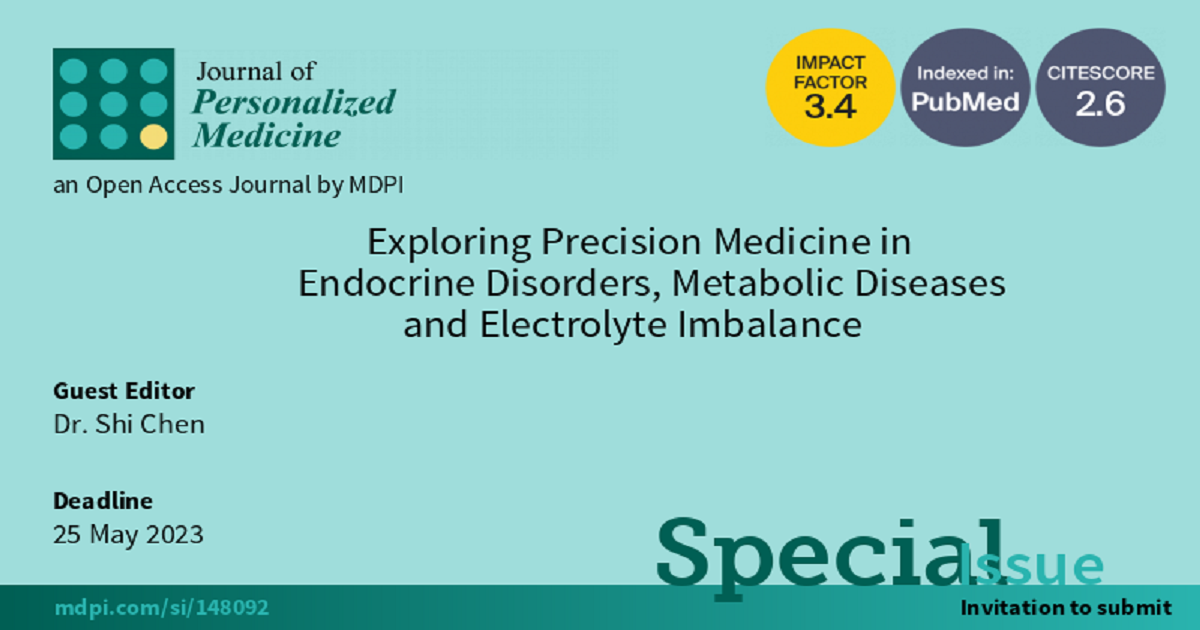Exploring Precision Medicine in Endocrine Disorders, Metabolic Diseases and Electrolyte Imbalance
A special issue of Journal of Personalized Medicine (ISSN 2075-4426). This special issue belongs to the section "Personalized Therapy and Drug Delivery".
Deadline for manuscript submissions: closed (25 May 2023) | Viewed by 4615

Special Issue Editor
Interests: endocrinology and metabolism; clinical epidemiology
Special Issue Information
Dear Colleagues,
Endocrine disorders, metabolic diseases, and electrolyte imbalance have led to growing numbers of patients in recent years. Due to the intricate regulation of hormone secretion and substance metabolism in the human body, the system disturbance varies in each patient most of the time. Precision medicine has provided innovative approaches for accurate diagnosis, outcome prediction, and personalized treatment based on individual factors. To date, the understanding of precision medicine in the field of endocrine and metabolic diseases is limited. This Special Issue aims to explore individualized medical strategies or novel perspectives that involve disorders or syndromes with hormone and/or substance imbalance. We welcome original research and reviews that cover, but are not limited to, the following potential sub-topics and methods:
- Newly identified cause or risk factors, differential diagnosis or subtyping, interpretation of atypical symptoms, evaluation of treatment effect, etc.
- We especially encourage the submission of interdisciplinary works and multi-country collaborative research. We welcome the submission of solid research articles/communications or review papers.
Dr. Shi Chen
Guest Editor
Manuscript Submission Information
Manuscripts should be submitted online at www.mdpi.com by registering and logging in to this website. Once you are registered, click here to go to the submission form. Manuscripts can be submitted until the deadline. All submissions that pass pre-check are peer-reviewed. Accepted papers will be published continuously in the journal (as soon as accepted) and will be listed together on the special issue website. Research articles, review articles as well as short communications are invited. For planned papers, a title and short abstract (about 100 words) can be sent to the Editorial Office for announcement on this website.
Submitted manuscripts should not have been published previously, nor be under consideration for publication elsewhere (except conference proceedings papers). All manuscripts are thoroughly refereed through a single-blind peer-review process. A guide for authors and other relevant information for submission of manuscripts is available on the Instructions for Authors page. Journal of Personalized Medicine is an international peer-reviewed open access monthly journal published by MDPI.
Please visit the Instructions for Authors page before submitting a manuscript. The Article Processing Charge (APC) for publication in this open access journal is 2600 CHF (Swiss Francs). Submitted papers should be well formatted and use good English. Authors may use MDPI's English editing service prior to publication or during author revisions.
Keywords
- electrolyte disorders
- endocrine metabolic diseases
- hyponatremia
- hypokalemia
- hypocalcemia
- hypermagnesemia
- glucose metabolism
- lipid metabolism






